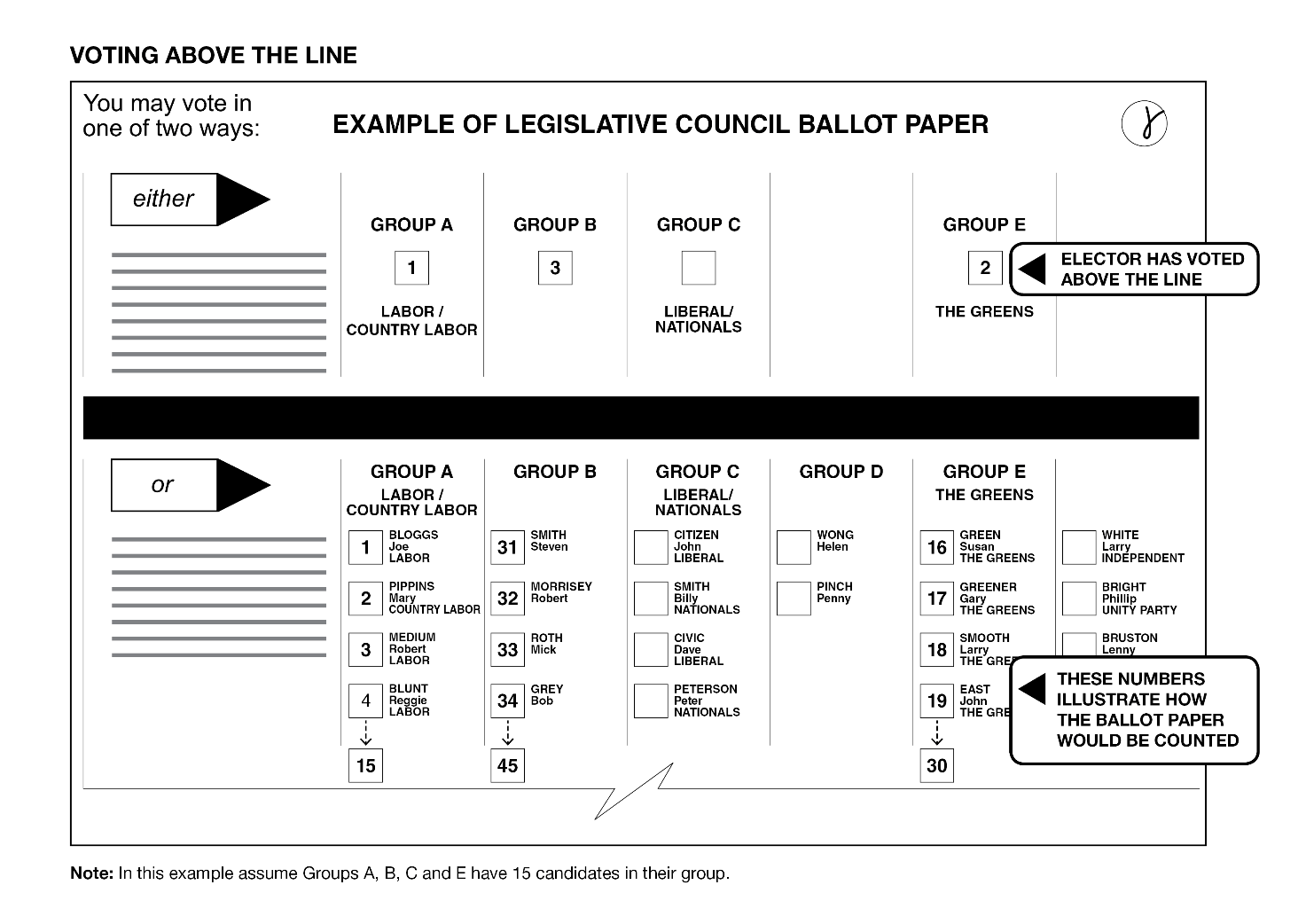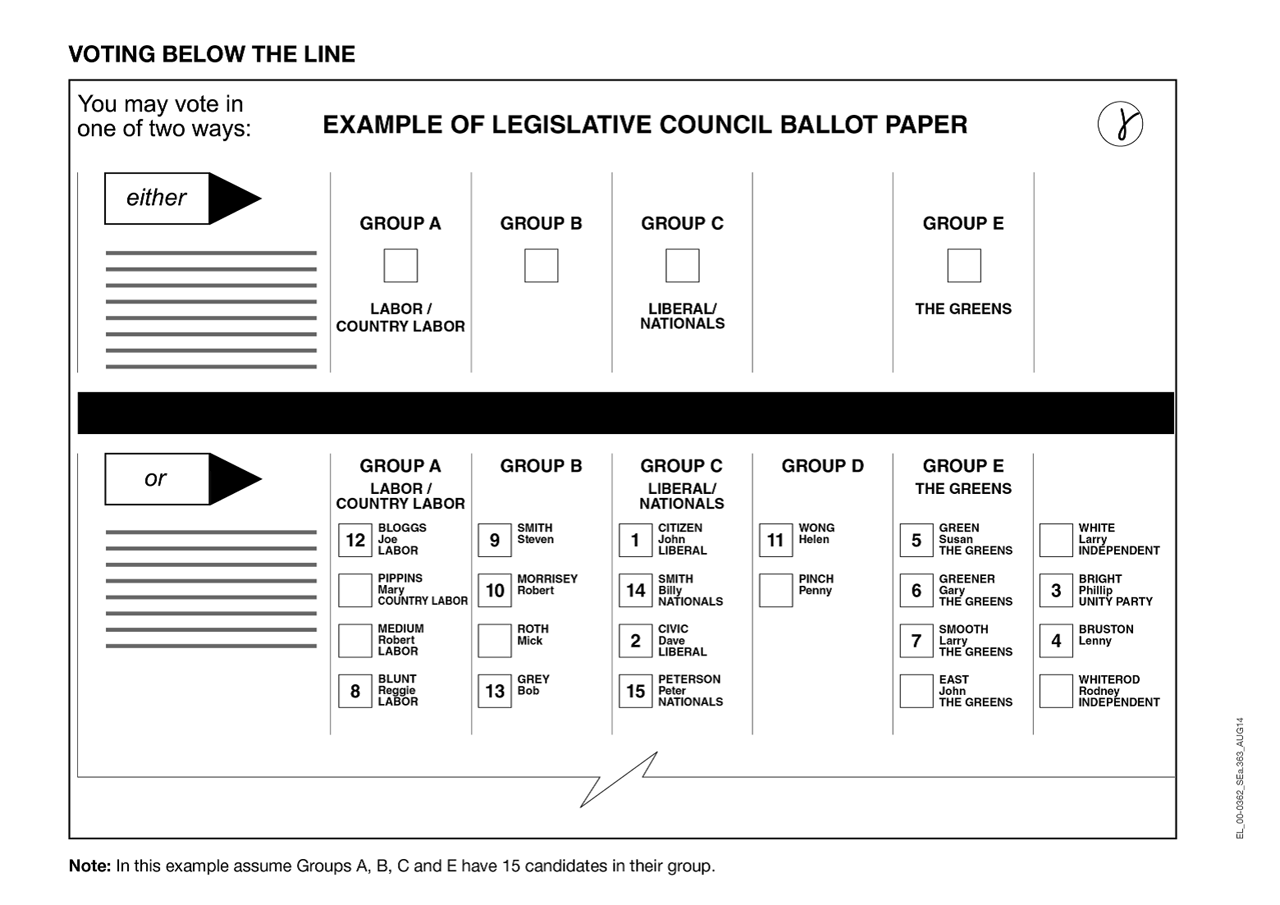Legislative Council: Voting and Counting
Legislative Council Voting
To cast a formal vote an elector may choose to vote either 'Above the Line' or 'Below the Line' on the Legislative Council ballot paper.
Voting Above the Line
If an elector chooses to vote 'Above the Line', they must place the number '1' in the Group Voting Square for the group of their choice.
The elector has the 'option' to show further preferences by placing the number '2' in the Group Voting Square next to their second choice group, the number '3' in the Group Voting Square next to their third choice group and so on. The elector may number as many or as few Group Voting Squares beyond their first choice group as they wish.
In the example Legislative Council ballot paper Figure 1, assume Groups A, B, C and E each have 15 candidates in their group. The elector has voted 'Above The Line'. The numbers 'Below The Line' illustrate how this ballot paper would be counted.
| Above The Line Vote | Counted |
| 1 for Group A 'Labor/Country Labor' | ballot paper is counted 1 to 15 in ballot paper order for the 15 candidates in Group A |
| 2 for Group E 'The Greens' | ballot paper is counted 16 to 30 in ballot paper order for the 15 candidates in Group E |
| 3 for Group B | ballot paper is counted 31 to 45 in ballot paper order for the 15 candidates in Group B |

Voting Below the Line
If an elector chooses to vote 'Below The Line' (BTL), they must vote for at least 15 candidates by placing the numbers '1' to '15' in the squares next to the candidates in the order of their choice.
The elector has the 'option' to show further preferences starting with the number '16' and so on.
They may number as many or as few squares beyond their 15th choice candidate as they wish.
When voting 'Below The Line', the elector is not required to vote for all candidates in a group before voting for candidates in another group.

Ballot papers marked above and below the line
If a ballot paper is marked both 'Above The Line' and 'Below The Line', and both sections are formal, the 'Below The Line' section takes precedence. If one section (above or below the line) is formal and the other informal, the formal section takes precedence.
Formality of Ballot Papers
If the elector does not vote in the manner described then the vote may be informal. However, the ballot paper may still be counted as formal, eg: a or a may be counted as a first preference mark in certain circumstances 'Above The Line'.
Legislative Council Counts
The NSW Electoral Commission (NSWEC) has workplace health and safety concerns about staff in voting centres working excessive hours on election day.
To address this concern and to ensure staff leave the voting centre at a reasonable time, the NSWEC will conduct the initial 1st preference count of the Legislative Council ballot papers to the following 7 groups only:
- Animal Justice Party
- Christian Democratic Party (Fred Nile Group)
- Labor/Country Labor
- Liberal/The Nationals
- Pauline Hanson's One Nation
- Shooters, Fishers and Farmers
- The Greens
All other ballot papers ie: those marked above the line for any other group, and those marked below the line, will be placed in the one 'Others' pile and reported as one total figure on election night.
This process will apply for all Legislative Council initial 1st preference counts for voting centres, early voting centres, iVote, postal and the various declaration vote types.
It is important to note that many of the ballot papers in the 'Others' pile will be formal and will be identified as such during the check count.
After the ballot papers have undergone an initial count they will again be re-examined during the check count which occurs in the weeks after Election Day. It is this check count, and subsequent distribution of preferences, which determines the elected candidates.
As the check count (batching and data entry) of the Legislative Council ballot papers commences at the Legislative Council Count Centre at Rosehill from Sunday, 24 March 2019 onwards, the NSWEC will progressively report to its website the 1st preference votes both above and below the line, for all groups and candidates that appear on the ballot paper.
It is estimated the progressive reporting of these check count figures on the NSWEC website will commence on Wednesday, 27 March 2019 and will continue daily up to Wednesday, 10 April 2019. The distribution of preferences to determine the 21 elected Legislative Council candidates, conducted within the NSWEC computer count system, is expected to take place on Friday, 12 April 2019.
Legislative Council Count Timetable
The following table is a guide to the timing and locations of the Legislative Council count.
Please note this timetable may be subject to change.
| Location and timing of counts | Initial count of the following Legislative Council (LC) ballot paper types |
| Voting centres from 6.00pm Saturday, 23 March | Voting centre ordinary LC ballot papers |
| Legislative Council Count Centre (LCCC) from 6.00pm Saturday, 23 March | LC Postals received up to Friday, 22 March |
| NSW Electoral Commission head office from 6.00pm Saturday 23 March (and may continue on Sunday 24 March) | LC iVote |
| Centralised Declaration Vote Count Centre (CDVCC) from 6:00pm Saturday 23 March | Sydney Town Hall Early Voting Centre ordinary LC ballot papers |
| Sydney Town Hall from 6:00pm Saturday 23 March | Election Day ordinary LC ballot papers |
| Election Manager office from Sunday 24 March (and will continue up to Friday, 29 March) | Early voting centres and Declared Facilities ordinary LC ballot papers |
| Centralised Declaration Vote Count Centre (CDVCC) from Monday 1 April (and will continue up to Thursday 4 April) | LC Postals received between Saturday 23 March and 6.00pm Wednesday 27 March. LC Absent, Enrolment and Name Already Marked as Voted (NAMAV) |
| Location and Timing of counts | Check Count and data entry of the following ballot paper types |
| Legislative Council Count Centre (LCCC) from Sunday 24 March (and will continue up to Wednesday 10 April) | All LC ballot papers |
| Location and Timing of counts | Distribution of Preferences (DoP) |
| NSW Electoral Commission on Monday 15 April at 11:00am | DoP to determine the elected candidates |
Legislative Council Distribution of Preferences
The Distribution of preferences (DoP) will take place at the NSW Electoral Commission in Sydney following the completion of check count and data entry. It is estimated the distribution of preferences will occur on Friday 12 April.
The distribution of preferences will be conducted in the NSW Electoral Commission's computer count system. The distribution of preferences is simply 'pressing a button' in the data entry system. The distribution of preferences will take approximately 30 minutes to complete.
Candidates, scrutineers, media and other interested parties are entitled to be present to witness the distribution of preferences.
Legislative Council Distribution of Preferences Example
Following is an example of how a distribution of preferences works.
Legislative Council members are elected using a proportional representation voting system.
To be elected, a candidate must typically attain a quota of the votes. The quota is calculated as follows:
For example, there are 21 members to be elected at the 2019 NSW State election. At the March 2015 NSW State Election there were 4,316,498 formal ballot papers. Therefore the quota was 4,316,498 ÷ 22 = 196,204.45. Disregard the fraction and add 1 = the Quota 196,205.
Some candidates will obtain the quota from the first preference votes alone. In these cases, all of the elected candidates' ballot papers are distributed according to their preferences. However, certain ballot papers are returned to the elected candidate to remain as the quota. Other candidates will be elected only when they obtain a quota as a result of the distribution of preferences. In these cases, only the surplus ballot papers received (ie: ballot papers in excess of the quota) will be distributed to other candidates. Candidates can also be elected without receiving a quota if the remaining number of candidates in the count equals the number of vacant positions still available.
Legislative Council results on the NSW Electoral Commission Virtual Tally Room
As the initial 1st preference count is conducted from 6.00pm election night onwards, the results will be displayed on the NSW Electoral Commission Virtual Tally Room (VTR) for the information of candidates, Registered Political Parties, the public and the media.
Initial 1st preference count results will be updated on the Virtual Tally Room as the initial counts progress for early voting, Declared Facilities, postal and declaration votes in the weeks after Election Day.
Check count 1st preference figures will be displayed on the Virtual Tally Room from Wednesday 27 March onwards.
As the check count and data entry progresses over the 3 week period of counting, a Legislative Council state summary report will be updated daily on the Virtually Tally Room.
Final Count Figures
Following the completion of the check count and data entry of all Legislative Council ballot papers and the conduct of the distribution of preferences in the NSW Electoral Commission's computer count system, the Virtual Tally Room will be updated with the following:
- 1st preference check count and other count reports
- Distribution of preferences results.
Return of the Writ
The Electoral Commissioner will endorse the name of the successful candidates on the Writ and will return the Writ to the NSW Governor.
Disputing an Election
Any person may challenge the results of an election by submitting a petition addressed to the Prothonotary of the Supreme Court within 40 days of the return of the Writ.
Any person who wishes to pursue this course of action is advised to seek their own legal advice.



